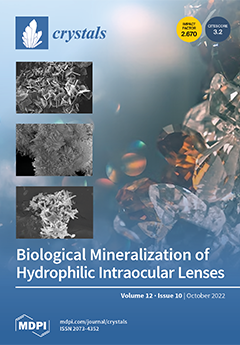Three new arsenato-polyoxovanadates with the composition [M(en)
3]
2[V
6As
8O
26] (M = Co
2+ (I), Zn
2+ (II), and Cd
2+ (III)) were synthesized under solvothermal conditions in high yields, thus significantly enhancing the knowledge of
[...] Read more.
Three new arsenato-polyoxovanadates with the composition [M(en)
3]
2[V
6As
8O
26] (M = Co
2+ (I), Zn
2+ (II), and Cd
2+ (III)) were synthesized under solvothermal conditions in high yields, thus significantly enhancing the knowledge of As-rich polyoxovanadate cluster chemistry. The compounds are isostructural and feature the very rare [V
6IVAs
8IIIO
26]
4− cluster anion. The cluster shell is constructed by interconnection of two trimeric {V
3O
11} groups consisting of three edge-sharing VO
5 polyhedra and four As
2O
5 units, which are formed by two corner-sharing AsO
3 pyramids. While the As
2O
5 group is a common structural feature in arsenato-polyoxovanadates, the {V
3O
11} unit is only observed in V-rich high-nuclear heteroatom-containing polyoxovanadates {V
14E
8} (E = As, Sb, Ge). The complexes adopt the Λ (δδδ) conformation, which is the most stable arrangement. Interestingly, the unit cell parameters do not scale with the volume of the [M(en)
3]
2+ complexes, assuming a constant volume of the anion. Only a very detailed Hirshfeld surface analysis revealed that the van der Waals volume of the {V
6As
8O
26} moiety is the smallest for the Cd-containing compound, while the volumes of the anions in the other two compounds are very similar. Therefore, the observed trends of the lattice parameters can be explained on the basis of these findings. Furthermore, intermolecular interactions include As⋯H contacts in addition to O⋯H and H⋯H interactions. The electronic spectrum of I contains d–d transitions of the vanadyl group and of the Co
2+ cation. As expected only the d–d transitions of the VO
2+ unit occur for II and III.
Full article





